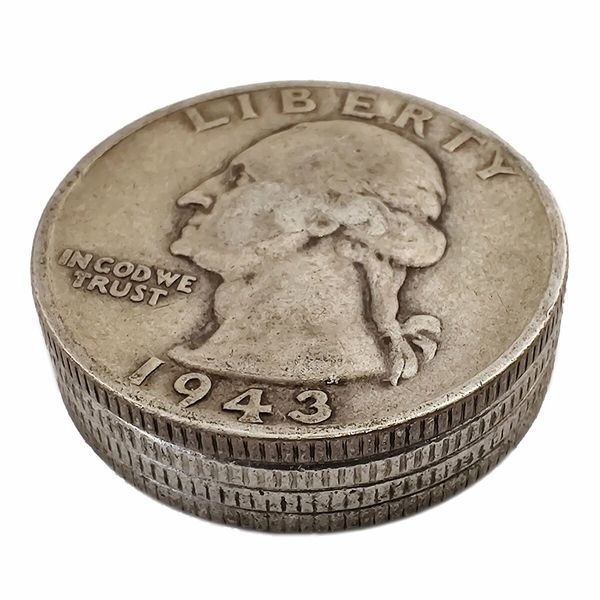Silver Quarters
90% Silver Quarters - Washington, Standing Liberty, and Barber
Silver Quarters Quick Facts

Quarters minted in the United States prior to 1965 were made of an alloy containing 90% silver. They are sometimes called Junk Silver because they have little to no numismatic value. Their worth is based on the intrinsic value of the metals.
90% Silver Quarters
So, each $1 face value of pre-1965 U.S. quarters contains approximately 0.715 troy ounces of silver. It's worth noting that circulation can vary, and some dealers may include coins with partial dates in some lots.
The worth of face value lots of silver quarters fluctuates based on the current silver price. Shop and compare to find which online bullion dealer has the lowest price for 90% junk silver quarters.
Pre-1965 silver quarters are a reliable store of value for investors looking for a low-cost investment. These quarters have a composition of 90% silver and 10% copper, sometimes called coin silver.
The intrinsic value can make these coins a good hedge against inflation or economic uncertainty, as precious metals most often retain their value over time relative to economic conditions.
Older silver quarters, particularly those in good condition or with rare mint marks or other features of interest can also have significant numismatic value to collectors even in circulated condition, adding to their worth above and beyond the raw silver value.
Because of their small size, junk silver quarters can be stored almost anywhere. This makes them one of the most liquid physical assets which can be useful if you ever want to sell only a portion of your precious metals holdings.
90% Silver quarters are instantly recognized for their intrinsic value, enabling easier barter transactions in a crisis situation.
Collecting Silver Quarters
Coin collectors and numismatists are passionate about silver quarters because there are so many unique design variations, an assortment of mint marks, and valuable error coins that can be found when buying silver quarters.
A complete set of Washington silver quarters contains over 80 coins, including mint mark and date combinations, and more than $20 face value! Die variations and error coins add even more to collect.
Various collector albums are available from Dansco and Whitman. They are a great way to learn about the history and all of the variations available in twenty-five-cent coins while building a useful store of value.
History of the Quarter Dollar
The quarter dollar coin has been part of the American economy since 1796. In total, there have been six unique and distinct designs for the coin spanning more than 225 years and until 1964, all of the quarters in circulation were minted from 90% silver.
-
Draped Bust Quarters (1796-1807): These were among the first quarters minted in the U.S., designed by Mint engraver Robert Scot. They featured a portrait of Lady Liberty on the obverse and a bald eagle on the reverse. These quarters were composed of 89.24% silver and 10.76% copper.
-
Capped Bust Quarters (1815-1838): The design was changed to a Liberty with a cap on her head. The composition remained the same as the Draped Bust quarters.
-
Seated Liberty Quarters (1838-1891): The design again changed to depict Liberty seated on a rock, holding a shield and a flag. The composition remained the same.
-
Barber Quarters (1892-1916): These quarters were designed by Charles E. Barber, the Chief Engraver of the U.S. Mint. They featured a profile of Lady Liberty on the obverse and an eagle on the reverse. The silver composition was slightly increased to 90% silver and 10% copper.
-
Standing Liberty Quarters (1916-1930): Designed by Hermon A. MacNeil, these quarters featured a standing Lady Liberty on the obverse and an eagle in flight on the reverse. The composition remained 90% silver and 10% copper.
-
Washington Quarters (1932-1964): The design switched to a profile of George Washington on the obverse. From 1932 to 1964, these quarters were composed of 90% silver and 10% copper. Starting in 1965, due to rising silver prices, the Mint changed the composition to copper-nickel clad.
Special issue quarters, such as the Bicentennial Quarter were minted in 1976, and the State Quarters Silver Proof Coin series (1999-2008), were also minted with a 90% silver composition. Silver quarters with errors, such as double dies, planchet errors, or other anomalies, can be highly sought after by collectors. Some rare quarters from various years and mint marks had low mintage figures, making them much more valuable than the face value.
Valuable Silver Quarters
There are various key dates for the Washington Quarter series that are considered rare and can be extremely valuable, even in circulated condition. For example, during the first year of issue, Washington Quarters were minted in relatively low numbers.
- 1932-D and 1932-S Washington Quarter - These quarters were minted during the first year of issue and are increasingly difficult to find. These coins are highly sought after by collectors and in circulated condition can fetch hundreds of dollars each.
- 1916 Standing Liberty Quarter - The 1916 Standing Liberty Quarter underwent a design change during the year, leading to two distinct types: the "Type 1" and "Type 2." The Type 2 variety, with a more covered Liberty, is scarcer and more valuable.
- 1950-D Washington Quarter - While not as old as some other coins on this list, the 1950-D Washington Quarter is considered rare when found in higher grades. It's part of the early Washington Quarter series and in MS67 condition, these coins have sold in recent auctions for more than $7,000 each.
- 1936 Washington Quarter Doubled Die Reverse - This is an extremely rare variety of the regular 1936 Washington Quarter. It's valuable due to a noticeable doubling of the design on the reverse side. Silver quarters with errors, such as double dies, planchet errors, or other anomalies, can be highly sought after by collectors.
Rarity alone is not always enough; collectors typically look for well-preserved examples. Proof coins are struck with special care for collectors. Certain proof silver quarters from specific years and mint marks can be rare and valuable. If you suspect you have a rare silver quarter, it's a good idea to have it appraised by a professional coin dealer or numismatist to determine its value and authenticity.
Modern Silver Quarters
Special issue silver quarters, such as the Proof Bicentennial Quarter (minted in 1976) and the Proof State Quarters series (1999-2008) and other special collectors' editions.
Frequently Asked Questions about Silver Quarters
- Question: What years were quarters are made from silver? - Answer: All quarters issued by the US Mint until 1964 where minted with 90% silver.
- Question: How many quarters are there in a standard bankroll? - Answer: A standard bankroll of quarters, sometimes called a shotgun roll, contain 40 twenty-five-cent coins, providing a total face value of $10 USD with an approximate silver weight of roughly 7.15 troy ounces.
- Question: What are the different styles of silver quarters? - Answer: There have been six distinct styles of silver quarters issued by the Mint, beginning with the Draped and Capped Busts, progressing through the Seated Liberty, Barber and Standing Liberty series', until reaching the Washington quarter series that is most familiar today.
Where to find the cheapest Silver Quarters
FindBullionPrices.com compares prices from trusted and reputable online precious metals dealers to help you find the lowest premiums when shopping for Silver Quarters. The prices on our site are updated hourly and adjusted for silver spot price, providing a tool that helps investors compare silver prices.
We help find the cheapest Silver Quarters when you're ready to buy.
You can find a large assortment of silver coins at FindBullionPrices.com. If we don't list prices for something you're looking for Contact Us and let us know so we can add it.
Compare Silver Quarters prices
FindBullionPrices.com compares Silver Quarters prices from top-rated and trusted bullion dealers. Our product listings compare the online prices to help you buy the cheapest Silver Quarters.








